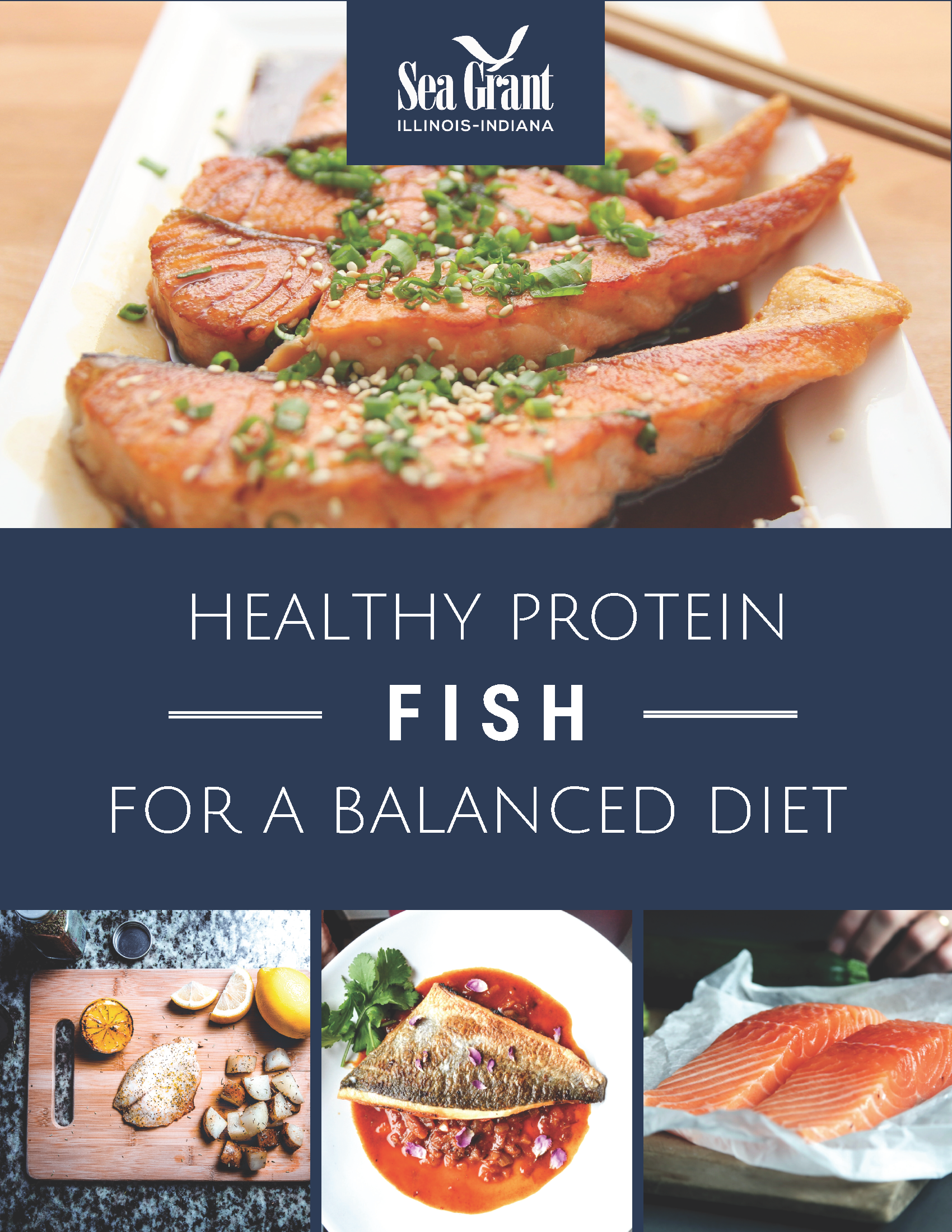Results
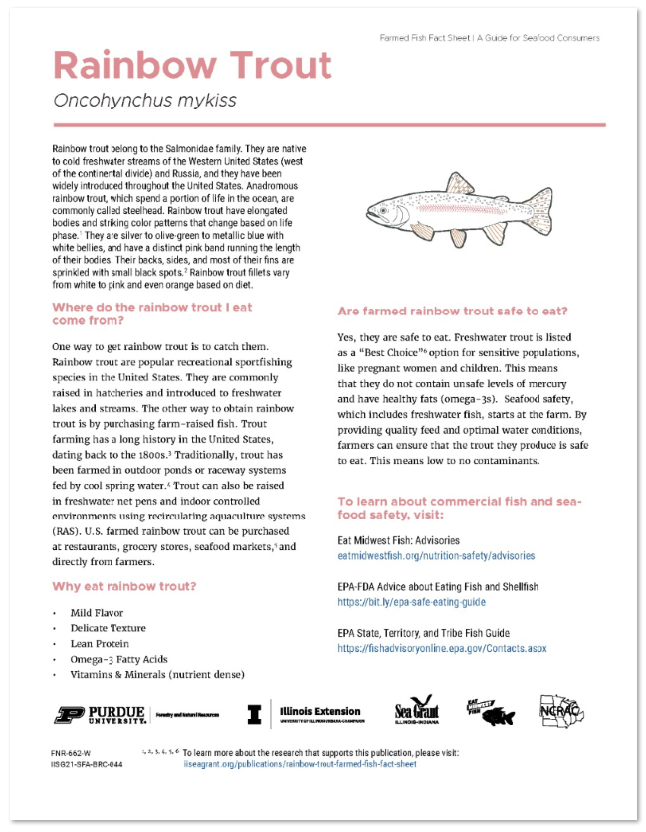
File Type: pdf
File Size: 4.10 MB
Year: 2021
This is the fourth in a series of consumer guides that describe fish and shellfish farmed in the Midwest region of the United States. (See Walleye Farmed Fish Fact Sheet, Yellow Perch Farmed Fish Fact Sheet, and Tilapia Farmed Fish Fact Sheet). The fact sheet also includes culinary characteristics, cooking tips, and a recipe for Grilled Rainbow Trout with Apricot Salsa.
References:
- Great Lakes Sea Grant Network. 2019. Salmon and Trout of the Great Lakes: A Visual Identification Guide. IISG19-LWD-BRC-023. https://iiseagrant.org/publications/salmon-and-trout-of-the-great-lakes-a-visual-identification-guide/.
- National Audubon Society. 2002. National Audubon Society Field Guide to Fishes. Chanticleer Press, Inc.
- Stickney, R.R. 1996. Aquaculture in the United States, A Historical Survey. John Wiley & Sons, New York, 372.
- Hardy, R.W. 2002. Nutrient Requirements and Feeding of Finfish for Aquaculture (p. 186). essay, CAB Pub.
- Ladewig, K.F. and Morat, M. 1995. Rainbow Trout. Southern Regional Aquaculture Center Publication No. 224.
- EPA-FDA Advice about Eating Fish and Shellfish. Available online: https://www.epa.gov/fish-tech/epa-fda-advice-about-eating-fish-and-shellfish.
Download File
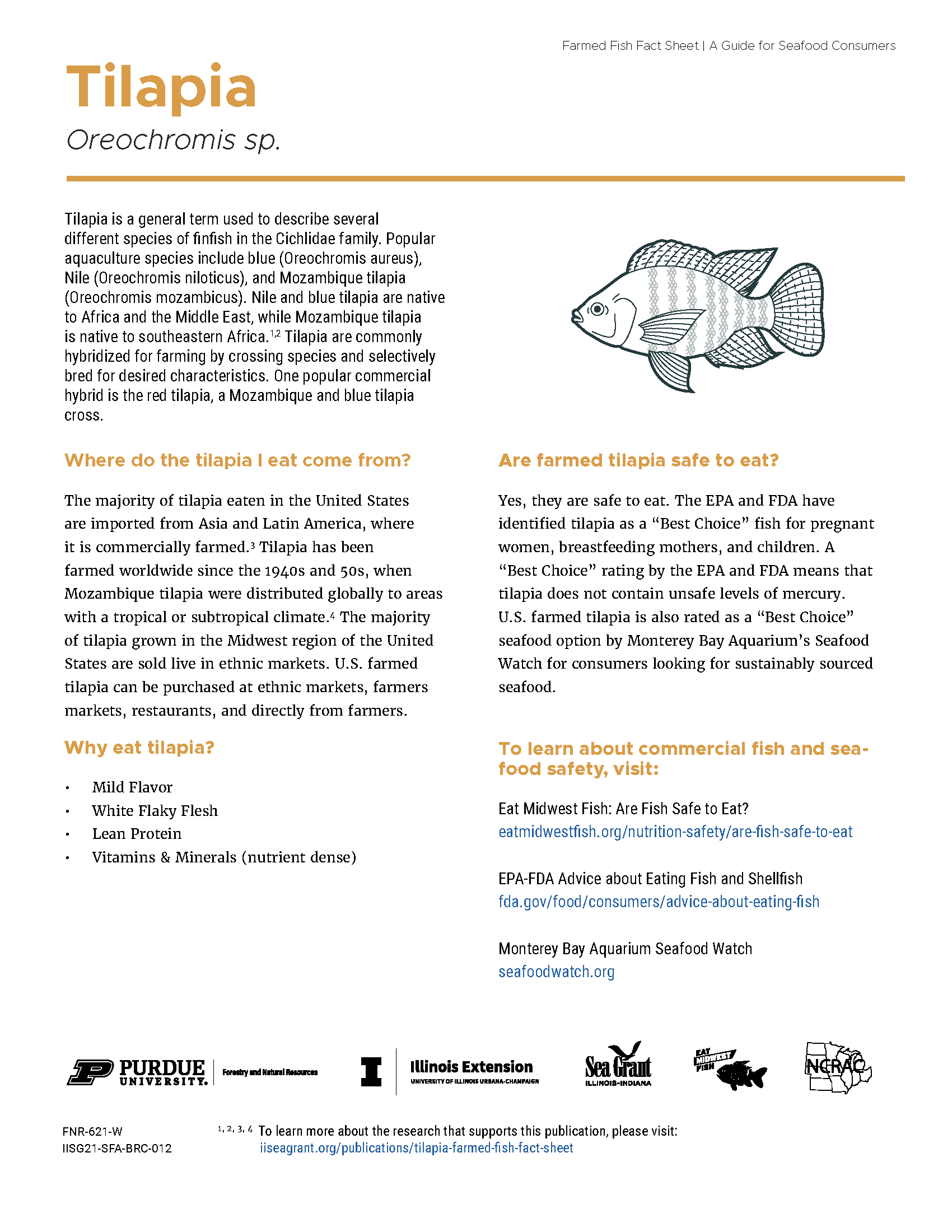
File Type: pdf
File Size: 4.35 MB
Year: 2021
This is the third in a series of consumer guides that describe fish and shellfish farmed in the Midwest region of the United States. The fact sheet also includes culinary characteristics, cooking tips and a recipe for Sautéed Tilapia.
References:
- Wohlfarth, G.W. and G. Hulata. 1983. Applied Genetics of Tilapias, ICLARM Studies and Reviews 6, 26 p. International Center for Living Aquatic Resources Management, Manila.
- Nico, L.G., Schofield, P.J., and Neilson, M.E., 2021, Oreochromis niloticus (Linnaeus, 1758): U.S. Geological Survey, Nonindigenous Aquatic Species Database, Gainesville, FL, https://nas.er.usgs.gov/queries/factsheet.aspx?SpeciesID=468, Revision Date: 1/8/2020, Peer Review Date: 12/18/2013, Access Date: 2/16/2021
- National Marine Fisheries Service (2020) Fisheries of the United States, 2018. U.S. Department of Commerce, NOAA Current Fishery Statistics No. 2018 Available at: https://www.fisheries.noaa.gov/ national/commercial-fishing/fisheries-united-states-2018
- FAO 2005-2021. Cultured Aquatic Species Information Programme. Oreochromis niloticus. Cultured Aquatic Species Information programme. Text by Rakocy, J.E. In: FAO Fisheries Division [Online]. Rome. Update 18 February 2005. [Cited 16 February 2021]. http://www.fao.org/fishery/culturedspecies/Oreochromis_niloticus/en
Download File
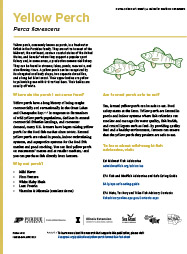
File Type: pdf
File Size: 4.34 MB
Year: 2021
This is the second in a series of fact sheets that describe fish and shellfish produced in the Midwest region of the United States. (See FNR-608-W, Walleye Farmed Fish Fact Sheet.) Yellow perch have been popular among anglers for many years, and since 2002, responding to greater demand, U.S. farmers are raising perch in ponds, aquaponic systems, etc. The fact sheet also includes culinary characteristics, cooking tips and a recipe for Baked Parmesan Perch.
References:
- Pam Fuller, and Matt Neilson, 2020, Perca flavescens (Mitchill, 1814): U.S. Geological Survey, Nonindigenous Aquatic Species Database, Gainesville, FL, https://nas.er.usgs.gov/queries/factsheet.aspx?SpeciesID=820, Revision Date: 8/15/2019, Peer Review Date: 5/29/2012, Access Date: 10/14/2020
- Brown T; Runciman B; Bradford M; Pollard S, 2009. A biological synopsis of yellow perch (Perca flavescens). Canadian Manuscript Reports of Fisheries and Aquatic Sciences, 2883. 28 p.
- Hudson, J. C. and Ziegler, S. S. (2014), Environment, Culture, and The Great Lakes Fisheries. Geographical Review, 104: 391–413. doi: 10.1111/j.1931-0846.2014.12041.x
- Piavis P. Yellow perch Perca flavescens. In: Funderburk SL, Jordan SJ, Mihursky JA, Riley D, editors. Habitat requirements for Chesapeake Bay living resources. 2nd edition. Solomons, MD: Chesapeake Research Consortium; 1991. p. 14.1-14.15.
- Malison, J.A. 2003. A white paper on the status and needs of yellow perch aquaculture in the north central region. Reported prepared for North Central Regional Aquaculture Center. Available at: http://ag.ansc.purdue.edu/aquanic/ncrac/wpapers/YellowPerch11-21-03.htm
Download File
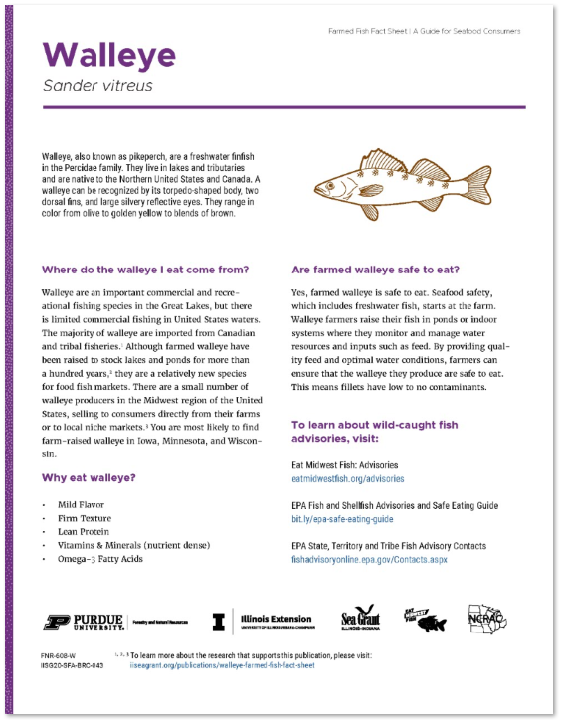
File Type: pdf
File Size: 3.77 MB
Year: 2020
This fact sheet is a consumer guide to farmed walleye. The publication describes walleye, walleye farming, product safety, and culinary characteristics of walleye in addition to cooking tips and a recipe.
References:
- Summerfelt, R.C., Kinnunen, R.E., Johnson, J.A., 2019. Production of Walleye as Potential Food Fish. North Central Regional Aquaculture Center Technical Bulletin #116, NCRAC Publications Office, Iowa State University, Ames. https://www.ncrac.org/files/biblio/WFS116secure.pdf
- Summerfelt, R.C., ed. 1996. Walleye culture manual. NCRAC Culture Series #101, NCRAC Publications Office, Iowa State University, Ames, Page 5. https://www.ncrac.org/files/page/files/Chapter1.pdf
- Williams, M.C.W., Murphy, E.W., McCarty H.B., Snyder, B.D. Schrank, C.S., McCann, P.J. Crimmins, B.S. 2017. Variation in the essential fatty acids EPA and DHA in fillets of fish from Great Lakes region. Journal of Great Lakes Research, 43, Pages 150–160. https://doi.org/10.1016/j.jglr.2017.03.001
Download File
File Type: pdf
File Size: 5.52 MB
Year: 2020
The Helm is a collection of recent IISG success stories, describing some of our research, outreach, and education efforts to address coastal and Great Lakes issues in Illinois and Indiana.
Download File
File Type: pdf
File Size: 5.85 MB
Year: 2020
This handout provides information on the nutritional of eating fish for consumers. This handout covers dietary recommendations, healths benefits including fish as a part of a balanced diet, and what to look for when purchasing fresh fish.
Citations
- U.S. Department of Health and Human Services and U.S. Department of Agriculture. 2015-2020 Dietary Guidelines for Americans. 8th Edition. December 2015. Available at http://health.gov/dietaryguidelines/2015/guidelines/.
- Tan MD, MPH, Z.S. Red blood cell omega-3 fatty acid levels and markers of accelerated brain aging. Neurology. 2012 Feb 28;78(9):658-664.
- FAO/WHO (2011). Report of the Joint FAO/WHO Expert Consultation on the Risks and Benefits of Fish Consumption. Rome, Food and Agriculture Organization of the United Nations; Geneva, World Health Organization, 50pp.
Download File
Page 4 of 7
Note: Some older Illinois-Indiana Sea Grant publications have not yet been restructured into ADA compliant formats. We are actively working on this. If you are having difficulty accessing a particular item in one of our databases, please contact iisg@purdue.edu with the name of the item and its URL for further assistance.






